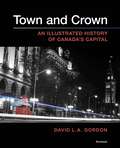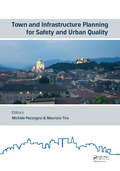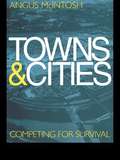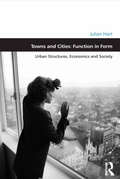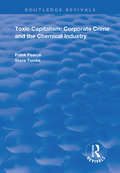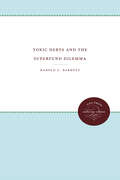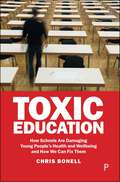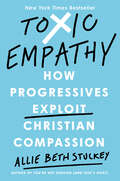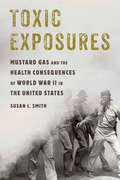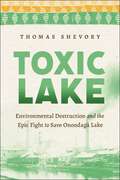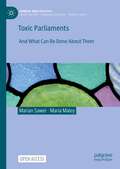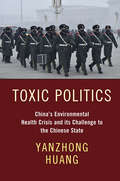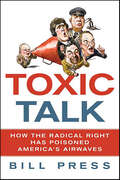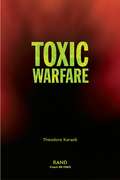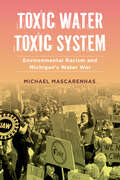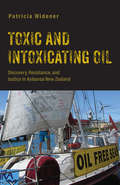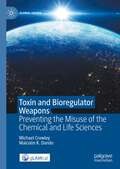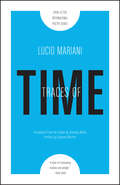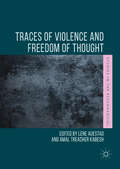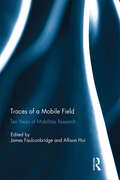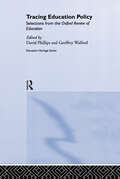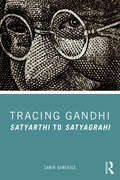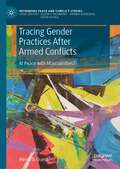- Table View
- List View
Town and Crown: An Illustrated History of Canada’s Capital
by David L. GordonTown and Crown is an illustrated history of the planning and development of Canada’s capital, filling a significant gap in our urban scholarship. It is the story of the transformation of the region from a subarctic wilderness portage to an attractive modern metropolis with a high quality of life. The book examines the period from 1800 to 2011 and is the first major study that covers both sides of the Ottawa River, addressing the settlement history of Aboriginal, French, and English peoples.Ottawa’s transformation was a significant Canadian achievement of the new profession of urban planning in the mid-20th century. Our national capital has the country’s most complete history of community planning and served as a gateway for important international planning ideas and designers. Town and Crown illustrates the influence of landscape architect and Olmsted protégé Frederick Todd, Chicago’s City Beautiful architect Edward Bennett, and British planner Thomas Adams. Prime Minister Mackenzie King maintained a direct interest in planning Canada’s capital for almost fifty years, choosing France’s leading urbaniste, Jacques Gréber, to plan the post-1945 redevelopment of the region.The principal research method for Town and Crown includes over sixteen years of archival studies in North America, Australia, and Europe, and interviews with key politicians, designers, and planners that supplemented the contemporary research. The narrative is supplemented by over 200 images drawn from early sketches, historical maps, plans, and archival photography to illustrate the physical transformation of Canada’s federal capital.
Town and Infrastructure Planning for Safety and Urban Quality: Proceedings of the XXIII International Conference on Living and Walking in Cities (LWC 2017), June 15-16, 2017, Brescia, Italy
by Michèle Pezzagno & Maurizio TiraToday, citizens advocate greater environmental sustainability, better services and the improvement of urban quality by promoting safer mobility, especially for the most vulnerable road users. Addressing these issues, Town and Infrastructure Planning for Safety and Urban Quality contains papers presented at the XXIII International Conference “Living and Walking in Cities” (Brescia, Italy, 15-16 June 2017). The contributions discuss town planning issues, look at best practices and research findings across the broad spectrum of urban and transport planning, with particular attention to the safety of pedestrians in the city. The main topics of the book are: - Urban regeneration. A focus on walkability (vulnerable road users; boosting and planning soft mobility)- Road safety and urban planning - vulnerable road users: planning for safety (integrated land use and transport planning; methodological approaches and case studies; integrated tools for town and transport planning; shaping public spaces and walkability; transport solutions for tourism)- Innovative and traditional solutions for Italian cities- Extra-European approaches to town and infrastructure planning- Different perspectives in road safety: prevention, infrastructure, sharing- Advances in road safety Town and Infrastructure Planning for Safety and Urban Quality is a powerful plea for a multi-disciplinary and comprehensive approach to urban mobility and planning, and will be of interest to academics, consultants and practitioners interested in these areas.
Towns and Cities: Competing for survival
by Angus McIntosh Dr Angus McintoshThe last fifty years have seen dramatic changes in towns and cities. People have moved out of central urban areas, retailing has moved out of towns and jobs have also declined in city centres, particularly with the growth of business and science parks. With the continuing decline of the manufacturing sector and the re-shaping of employment in the service sector, a new force will increasingly dominate urban development, the meritocratic elite. The meritocratic elite are those able to develop and use information technology to generate productivity and wealth. Where they wish to live will increasingly influence future urban development.Towns and Cities - Competing for survival suggests that as public and private corporations continue to downsize, outsource and re-engineer themselves, an increasing amount of expenditure and employment growth will lie with the leisure sector. Herein lies one of the solutions to the decline of towns and cities.Town planners and economists have continually displayed a lack of understanding of these developments and have not anticipated the forces which cause urban change. As the global econonmy, combined with changes in transport and information technology increasingly dominates our lives, local and national governments need a new agenda for the 21st century. If they fail to rise to this challenge many of our town and city centres will continue to decline and may not survive.
Towns and Cities: Urban Structures, Economics and Society (Design and the Built Environment)
by Julian HartChallenging existing assumptions about how our towns and cities are structured and formed, Julian Hart provides an engaging and thought-provoking alternative theory of urban design. This is not urban design in the sense of the practice of design; rather it is a theory of the form of the town at all scales - why towns and cities happen to be structured the way they are as a result of the social, political, legal and (especially) economic forces that create them. The shape of the city at every scale, from the internal configuration of dwellings all the way up to the superstructure of the whole city, can be seen to arise from the interplay between three antagonistic socio-economic tensions. In going about our daily business and in championing particular political objectives, we collectively fashion our cities in terms of their structure and form. This leads to various new ways of understanding how and why our cities so happen to be configured the way they are. The book makes a step change from any other comparable studies by understanding our towns and cities in terms of function in form. This helps us to appreciate why every town is a recognisable town, wherever it is. Different urban environments in different parts of the world, past and present, can come to be seen according to their similarities instead of their differences. Furthermore, by appreciating how the economic influences of everyday life structure our towns and cities, we can in turn begin to understand better how the shape of towns and cities affects the quality of life of inhabitants and the cohesiveness of communities. In covering all scales from inside the home to macrostructure of the city, the book encapsulates urban design through to town planning and does not seek to distinguish between the various design disciplines.
Toxic Capitalism: Corporate Crime and the Chemical Industry (Routledge Revivals)
by Steve Tombs Frank PearceOriginally published in 1998. While there is a growing academic literature on corporate crime, much of this focuses upon variants of economic or financial crimes; there is a relative absence of studies of safety, health and/or environmental crimes. This is curious given that recent years have witnessed a resurgence in popular, academic and indeed state attention to questions related to environmental degradation and human safety. Certainly in the latter context there is some recognition that environmental degradation must be understood partly in terms of environmental crimes by corporations. Moreover, recent experience in both the US and the UK attests to the fact that there is no ineluctable trend towards safer and healthier workplaces, as deregulatory movements have resulted in increased risks for most workers and, this text argues, an increased opportunity for, and incidence of, safety crimes. At the centre of environmental, safety and health isses lie the chemicals industries. These industries are of strategic importance to national economies, while also having almost unique hazard and risk potential and it is for these reasons that these are the focus of this text. Any understanding of the nature of these types of corporate crimes, and thus any recognition of the potential for their more effective regulation, requires an analysis that is grounded in more general sociological concerns and in political economy. For this reason, this text emphasises the need for understandings of the nature of contemporary and emergent forms of corporate organisation, of their place in contemporary economies, and of the relationships between these forms and state formations.
Toxic Debts and the Superfund Dilemma
by Harold C. BarnettIn 1980, with the passage of the Comprehensive Environmental Response, Compensation, and Liability Act, Congress created the Superfund as a mechanism to clean up the toxic legacy of the industrial and chemical revolutions. Over a decade later, the consensus is that the program has failed: too much has been spent and too little accomplished. Harold Barnett unravels the history of this failure, examining the economic and political factors that contributed to it and suggesting policy changes necessary to create a viable cleanup program. Barnett argues that the Superfund has failed because of conflict over who will pay the toxic debt and the impact of this conflict on interdependent funding and enforcement decisions at state, regional, and national levels. He argues that the inability of legislators and regulatory agencies to take effective and timely action is related to the economic and political power of major corporate polluters. Spanning the Reagan and Bush administrations, the book highlights the ongoing conflict between deregulatory policies and environmental programs.Originally published in 1994.A UNC Press Enduring Edition -- UNC Press Enduring Editions use the latest in digital technology to make available again books from our distinguished backlist that were previously out of print. These editions are published unaltered from the original, and are presented in affordable paperback formats, bringing readers both historical and cultural value.
Toxic Education: How Schools Are Damaging Young People’s Health and Wellbeing and How We Can Fix Them
by Chris BonellYoung people’s mental health is in crisis, with many – especially those from disadvantaged backgrounds – struggling academically and with the later transition to employment. Feeling excluded, many young people turn to harmful behaviours, such as vaping and alcohol use, for escape and a sense of belonging. Schools are increasingly expected to address these issues but often lack the time and expertise to do so effectively. Based on the author’s research, including the successful ‘Learning Together’ trial – an innovative programme that improved mental health, reduced bullying and raised academic achievement – this book provides a blueprint for a fundamental shift in how schools support young people. Essential reading for teachers, public health workers and policy makers tackling the health and educational inequalities affecting young people today.
Toxic Empathy: How Progressives Exploit Christian Compassion
by null Allie Beth StuckeyA sharp Christian voice makes a bold argument: when politics are driven by empathy rather than truth, innocent people pay the price. We are told that empathy is the highest virtue—the key to being a good person. Is that true? Or has “empathy,” like so many other words of our day—“tolerance,” “justice,” “acceptance”—been hijacked by bad actors who exploit compassion for their own political ends? In Toxic Empathy, Allie Beth Stuckey argues that empathy has become a tool of manipulation by left-wing activists who bully people into believing that they must adopt progressive positions to be loving. She explores the five most heated issues through which toxic empathy is deployed: abortion, gender, sexuality, immigration, and social justice. Progressives use catchy mantras to present their perspective as empathetic, like “abortion is healthcare,” “love is love,” or “no human being is illegal,” but in each case, they ignore the other side of the moral equation. For example, abortion is presented as compassionate for the woman, but what about the human life the procedure kills? This book isn’t about killing empathy; it’s about submitting our empathy to God’s definitions of love, goodness, and justice. Stuckey exposes the logical pitfalls and moral consequences of toxic empathy, equipping Christians with research-backed, Biblical truths to dismantle the progressive lies that have permeated our culture—and our church. <br><b>New York Times Bestseller</b></br>
Toxic Exposures: Mustard Gas and the Health Consequences of World War II in the United States
by Susan L. SmithMustard gas is typically associated with the horrors of World War I battlefields and trenches, where chemical weapons were responsible for tens of thousands of deaths. Few realize, however, that mustard gas had a resurgence during the Second World War, when its uses and effects were widespread and insidious. Toxic Exposures tells the shocking story of how the United States and its allies intentionally subjected thousands of their own servicemen to poison gas as part of their preparation for chemical warfare. In addition, it reveals the racialized dimension of these mustard gas experiments, as scientists tested whether the effects of toxic exposure might vary between Asian, Hispanic, black, and white Americans. Drawing from once-classified American and Canadian government records, military reports, scientists' papers, and veterans' testimony, historian Susan L. Smith explores not only the human cost of this research, but also the environmental degradation caused by ocean dumping of unwanted mustard gas. As she assesses the poisonous legacy of these chemical warfare experiments, Smith also considers their surprising impact on the origins of chemotherapy as cancer treatment and the development of veterans' rights movements. Toxic Exposures thus traces the scars left when the interests of national security and scientific curiosity battled with medical ethics and human rights.
Toxic Lake: Environmental Destruction and the Epic Fight to Save Onondaga Lake
by Thomas Shevory2024 Outstanding Academic Title, given by Choice ReviewsThe environmental history of “the most polluted lake in America.”Native Americans have long regarded Onondaga Lake as one of the most sacred spaces in the continent, the place where peace between nations was achieved and the Haudenosaunee Confederacy was created. In the mid-twentieth century, however, it acquired a wholly different reputation as “the most polluted lake in America.” Toxic Lake is an environmental history of this complex ecological system, tracking how it was tarnished, the costly efforts to clean it up, and the controversies those efforts generated.Thomas Shevory argues that the history of Onondaga Lake mirrors the larger environmental history of the US, from colonization to the industrial era, resulting, eventually, in the rise of social movements and legislative action for environmental protection. Layered within this history is the dismissal of indigenous land claims and the marginalization of indigenous voices in clean-up efforts. Toxic Lake illustrates that the failure to prevent the environmental destruction of Onondaga Lake was part of a political climate which favored unregulated industrial production and urban growth, ignoring the destructive impacts on local environments. Shevory argues this larger failure was the result of an active process of privileging the economic interests of polluters over other business interests, expanding neighborhoods, and indigenous rights. He concludes with an investigation of New York’s recent declaration that the clean-up is complete, questioning what exactly that means and whether the lake’s status as a sacred space will ever be re-established. Toxic Lake is a compelling work of history, demonstrating the disastrous effects of pollution and the importance of community involvement in environmental activism.
Toxic Parliaments: And What Can Be Done About Them (Gender and Politics)
by Marian Sawer Maria MaleyThis open access book shows how the #MeToo movement and revelations of sexual harassment and bullying have spurred on reform of the parliamentary workplace in four Westminster countries – Australia, Canada, New Zealand and the UK. Long-standing conventions included extreme power imbalances between parliamentarians and staff and a lack of professionalised employment practices. Codes of conduct and independent complaints bodies were resisted on grounds of parliamentary privilege: the ballot box was supposedly the best means of holding parliamentarians accountable for their conduct. The taken-for-granted status of adversarial politics and its silencing effects also rendered gendered mistreatment invisible. The authors examine the institutional backdrop and the different trajectories of reform in the four countries, with most detail on the dramatic developments in Australia after angry women marched on parliament houses in 2021. They show how the different parliaments have responded to escalating evidence of misconduct, the role of policy borrowing, and the possibilities of lasting institutional change.
Toxic Politics: China's Environmental Health Crisis and its Challenge to the Chinese State
by Yanzhong HuangEnvironmental degradation in China has not only brought a wider range of diseases and other health consequences than previously understood, it has also taken a heavy toll on Chinese society, the economy, and the legitimacy of the party-state. In Toxic Politics, Yanzhong Huang presents new evidence of China's deepening health crisis and challenges the widespread view that China is winning the war on pollution. Although government leaders are learning, stricter and more centralized policy enforcement measures have not been able to substantially reduce pollution or improve public health. Huang connects this failure to pathologies inherent in the institutional structure of the Chinese party-state, which embeds conflicting incentives for officials and limits the capacity of the state to deliver public goods. Toxic Politics reveals a political system that is remarkably resilient but fundamentally flawed. Huang examines the implications for China's future, both domestically and internationally.
Toxic Talk: How the Radical Right Has Poisoned America's Airwaves
by Bill PressA timely cannon blast at the right-wing media machine and how it subverts the principles of democratic representation Talk radio has done an end run around the voting populace. With Rush Limbaugh now the unofficial leader of the Republican Party and the far right controlling the five major syndicates, conservatives have a disproportionate voice in the medium—even in liberal cities such as New York, Boston, and San Francisco. Writing with his characteristic and incisive wit, Bill Press exposes the destructive power of Rush, Glenn Beck, Mark Levin, Sean Hannity, Michael Savage, Bill O'Reilly, and the other polarizing figures of talk radio who dominate 90% of the political airwaves today. Citing their own words as evidence, Press brilliantly makes the case that much of what is broadcast on radio and television today is—at best—distorted and partisan, and—at worst—lies, propaganda and bigotry sold by these talented modern-day pitchmen who have followings in the millions.
Toxic War: The Story of Agent Orange
by Peter SillsThe war in Vietnam, spanning more than twenty years, was one of the most divisive conflicts ever to envelop the United States, and its complexity and consequences did not end with the fall of Saigon in 1975. As Peter Sills demonstrates in Toxic War, veterans faced a new enemy beyond post-traumatic stress disorder or debilitating battle injuries. Many of them faced a new, more pernicious, slow-killing enemy: the cancerous effects of Agent Orange.Originally introduced by Dow and other chemical companies as a herbicide in the United States and adopted by the military as a method of deforesting the war zone of Vietnam, in order to deny the enemy cover, Agent Orange also found its way into the systems of numerous active-duty soldiers. Sills argues that manufacturers understood the dangers of this compound and did nothing to protect American soldiers.Toxic War takes the reader behind the scenes into the halls of political power and industry, where the debates about the use of Agent Orange and its potential side effects raged. In the end, the only way these veterans could seek justice was in the court of law and public opinion. Unprecedented in its access to legal, medical, and government documentation, as well as to the personal testimonies of veterans, Toxic War endeavors to explore all sides of this epic battle.
Toxic War: The Story of Agent Orange
by Peter SillsThe war in Vietnam, spanning more than twenty years, was one of the most divisive conflicts ever to envelop the United States, and its complexity and consequences did not end with the fall of Saigon in 1975. As Peter Sills demonstrates in Toxic War, veterans faced a new enemy beyond post-traumatic stress disorder or debilitating battle injuries. Many of them faced a new, more pernicious, slow-killing enemy: the cancerous effects of Agent Orange. Originally introduced by Dow and other chemical companies as a herbicide in the United States and adopted by the military as a method of deforesting the war zone of Vietnam, in order to deny the enemy cover, Agent Orange also found its way into the systems of numerous active-duty soldiers. Sills argues that manufacturers understood the dangers of this compound and did nothing to protect American soldiers.Toxic War takes the reader behind the scenes into the halls of political power and industry, where the debates about the use of Agent Orange and its potential side effects raged. In the end, the only way these veterans could seek justice was in the court of law and public opinion. Unprecedented in its access to legal, medical, and government documentation, as well as to the personal testimonies of veterans, Toxic War endeavors to explore all sides of this epic battle.
Toxic Warfare
by Theodore W. KarasikThe past several years have seen an increase in the use of toxic weapons -- i.e., inexpensive and easily acquired chemicals and industrial waste -- on the part of state as well as nonstate actors. Nonetheless, little analysis has been done on the nature and extent of this threat either to the military or to the U.S. homeland. This report examines the implications of toxic weapon use for military planning and concludes that such weapons merit further analysis.
Toxic Water, Toxic System: Environmental Racism and Michigan's Water War
by Prof. Michael MascarenhasThe tireless resistance of local communities fighting for ownership of America’s third largest water system Toxic Water, Toxic System exposes the consequences of a seemingly anonymous authoritarian state willing to maintain white supremacy at any cost—including poisoning an entire city and shutting off water to thousands of people. Weaving together narratives of frontline activists along with archival data, Michael Mascarenhas provides a powerful exploration of the political alliances and bureaucratic mechanisms that uphold inequality. Drawing from three years of ethnographic fieldwork in Flint and Detroit, this book amplifies the voices of marginalized communities, particularly African American women, whose perspectives and labor have been consistently overlooked. Toxic Water, Toxic System offers a fresh perspective on the ties between urban austerity policies, environmental harm, and the advancement of white supremacist agendas in predominantly Black and brown cities.
Toxic and Intoxicating Oil: Discovery, Resistance, and Justice in Aotearoa New Zealand (Nature, Society, and Culture)
by Patricia WidenerWhen oil and gas exploration was expanding across Aotearoa New Zealand, Patricia Widener was there interviewing affected residents and environmental and climate activists, and attending community meetings and anti-drilling rallies. Exploration was occurring on an unprecedented scale when oil disasters dwelled in recent memory, socioecological worries were high, campaigns for climate action were becoming global, and transitioning toward a low carbon society seemed possible. Yet unlike other communities who have experienced either an oil spill, or hydraulic fracturing, or offshore exploration, or climate fears, or disputes over unresolved Indigenous claims, New Zealanders were facing each one almost simultaneously. Collectively, these grievances created the foundation for an organized civil society to construct and then magnify a comprehensive critical oil narrative--in dialogue, practice, and aspiration. Community advocates and socioecological activists mobilized for their health and well-being, for their neighborhoods and beaches, for Planet Earth and Planet Ocean, and for terrestrial and aquatic species and ecosystems. They rallied against toxic, climate-altering pollution; the extraction of fossil fuels; a myriad of historic and contemporary inequities; and for local, just, and sustainable communities, ecologies, economies, and/or energy sources. In this allied ethnography, quotes are used extensively to convey the tenor of some of the country’s most passionate and committed people. By analyzing the intersections of a social movement and the political economy of oil, Widener reveals a nuanced story of oil resistance and promotion at a time when many anti-drilling activists believed themselves to be on the front lines of the industry’s inevitable decline.
Toxin and Bioregulator Weapons: Preventing the Misuse of the Chemical and Life Sciences (Global Issues)
by Michael Crowley Malcolm R. DandoThis book explores how revolutionary developments and convergence of the chemical, life and associated sciences are impacting contemporary toxin and bioregulator research, and examines the risks of such research being misused for malign purposes. Investigating illustrative cases of dual use research of potential concern in China, India, Iran, Russia, Syria and the USA, the authors discuss how states can ensure such research and related activities are not utilised in weapons development. Although toxins and bioregulators are, in theory, covered by both the Biological and Toxin Weapons Convention and Chemical Weapons Convention, this apparent overlap in reality masks a dangerous regulatory gap – with neither Convention implemented effectively to address threats of weaponisation. This book highlights the potentially damaging consequences for international peace and security, and proposes realistic routes for action by states and the scientific community.
Traces of Time
by Lucio Mariani Anthony Molino"Mariani has emerged as one of the few significant post-Montalian poets in Italy, and Molino is a graceful, experienced, thoroughly reliable translator. The result is an elegant book, an important book, bringing a distinctive voice into English."--Rosanna WarrenCulled from his entire career, the poems in Traces of Time cover numerous themes, most prominently the poet's relationship to history and how poetry can exist outside of it. "Tiananmen, 20 Years Later," "Protocols of War," and "Checkmate" (about 9/11) all illustrate Lucio Mariani's concerns "through images both dense and porous, lines both cadenced and spasmodic," and confirm his place in contemporary poetry."Protocols of War"(Baghdad is not far)Of this time you'll gather no memoriesfor your eternal hunger.Can't you see the slags in the weavethat enfolds the flesh of the living?Can't you see that the boxes and drawerswhere the silver of bygone days aboundshave no room for trinkets or seashellsof a present founded on plaster markets,lost facing a mirrorseeking itself in the halls of the world?Don't you see that for the first timeevery man erects ruins for his heirsenacting inane protocols of warwhile the future slams its shutters tightso as to celebrate on statistical altarsthe glory of mindless marionettesmaneuvered by nothingness,sprung in the bitter fields of oblivion?Of this time you'll gather no memories.Lucio Mariani is the author of eight volumes of poetry, including Echoes of Memory (available in English from UPNE), as well as a volume of essays, a collection of short stories, and translations of works by César Vallejo, Tristan Corbière, and Yves Bonnefoy.Anthony Molino is a translator from the Italian, an anthropologist, and a psychoanalyst. In addition to Lucio Mariani's two volumes, he has also translated works by Valerio Magrelli and Antonio Porta, among others.
Traces of Violence and Freedom of Thought
by Lene Auestad Amal Treacher KabeshThis book examines how people cannot escape being tainted, whether actively engaged or not, by violence in its countless manifestations. The essays encompass a wide range of theoretical resources, methodological approaches and geo-political areas. They describe how images and fragments of traumatic and violent scenarios are transported from one generation's unconscious to that of another, leading to cycles of repetition and retaliation, restricting the freedom to imagine alternatives and inhabit alternative positions. The authors all work within a psychosocial framework by unsettling the boundaries between psyche-social. Four themes are addressed: violence of speech, violence and domination, repetition and violence, and the possibility of reparation or renewal. Due to its theoretical engagements and the case studies provided, this interdisciplinary collection will be of value to postgraduate and undergraduate students of psychology, philosophy, politics and history.
Traces of a Mobile Field: Ten Years of Mobilities Research
by Allison Hui James FaulconbridgeThis agenda-setting collection critically reflects upon a decade of contributions to the social scientific ‘mobilities turn’ in order to propose new trajectories for the future of this interdisciplinary research field. The chapters are all exemplars of how the past decade of research has opened up new insights into the place of mobilities in societies. They also highlight how attempts to look forward towards new conversations, understandings, and interventions in a mobile world will emerge from the transformations invoked by this field of research. Authors foreground issues of power, interdisciplinarity, transformative technologies, fragmented discourses and changing social processes whilst addressing automobility, aeromobility, tourism, communications technologies, urban infrastructures, migration, and emergencies. As a whole, the collection raises important questions about not only how understandings of mobilities are changing, but also how the field of mobilities research is itself on the move. The evocative empirical cases and provocative arguments in this book thus highlight the necessity of new concepts, conversations, methods, empirical studies and interventions to address transformations in both the complex mobilities of social worlds and what is examined or taken for granted in mobilities research itself. This book was originally published as a special issue of Mobilities.
Tracing Education Policy: Selections from the Oxford Review of Education (Education Heritage)
by David Phillips Geoffrey WalfordThis book brings together key articles that trace the development of British education policy since 1975 and provides a valuable route map to developments within education policy during this period. It includes twenty-six seminal articles from the Oxford Review of Education written by many of the leading authors in the field and covering issues and topics with a wide significance beyond Britain. In one, easy-to-access place, this authoritative reference book provides a collection of articles that have made an important impact on policy studies and cover a broad range of significant policy issues, including: equality in education school effectiveness special educational needs school choice fourteen to nineteen education the structure of the educational system. The book has been compiled by the current editors of the journal to show the development of the field, and their specially written introduction contextualises the selection and introduces students to the main issues and current thinking in the field.
Tracing Gandhi: Satyarthi to Satyagrahi
by Samir BanerjeeThis book traces the journey of Mahatma Gandhi, from being a simple and truth-seeking human being, a satyarthi, to a committed, conscious and social human being, a satyagrahi. It specifically looks at this critical transformation during the time Gandhi was in South Africa. The central argument of the book is that Gandhi evolved from being a satyarthi to a satyagrahi in South Africa. Subsequently in India, he consolidated his orientation with an emphasis on praxis, by developing his ideas as instruments for social and individual struggles. Marked by a series of events, this period was an intense quest of self-realization and understanding, and shows his journey from being Mohandas Karamchand Gandhi to being Mahatma Gandhi. The book discusses various elements of Gandhian thought and praxis – morality, wisdom, non-violence, truth, social justice, dharma, trusteeship, education, sarvodaya, Hind Swaraj, swadeshi, and social service – and interprets the relevance of Gandhi’s thought in the modern world by highlighting its unique significance for social transformation and change. Lucid and accessible, the book will be useful to scholars and researchers of Gandhi studies, Indian political thought, modern Indian history, and political studies.
Tracing Gender Practices After Armed Conflicts: At Peace with Masculinities? (Rethinking Peace and Conflict Studies)
by Hendrik QuestThis book offers a unique perspective on changing gender practices in post-conflict societies, looking at when and how masculinities change after armed conflicts. Building on original research data from Liberia, chapters look at the pathways of change in societal discourses, security sector institutions, and at the level of formatter combatants. Scrutinising the potential of peacebuilding for making conflict-related masculinities change after armed conflicts, the book develops a theoretical model that helps to understand both how violence-centred masculinities change after armed conflicts, and why profound changes of violent gender practices occur only rarely. What this book hopes to show is that masculinities can and do change after armed conflicts. Illuminating the intricate interrelationship between gendered practices within societal discourses, security sector institutions, and at the individual level in post-conflict societies, this book constitutes an invitation to rethinking our understanding of peacebuilding practices and their interconnectedness with gender, violence, and peace.
